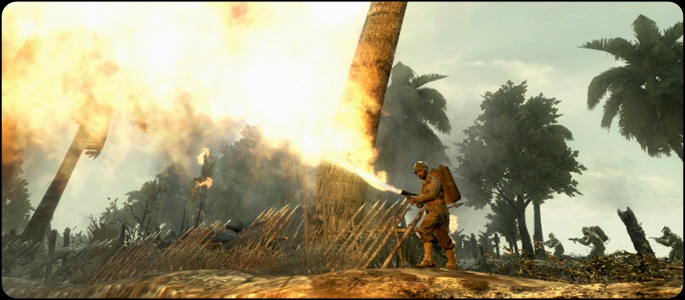It’s amazing what two developers can do with one engine. Call of Duty 4: Modern Warfare was a huge hit, and, as usual, Activision Blizzard wanted a Call of Duty game to be released the year after. Treyarch, the team behind Call of Duty 3, once again stepped up to the plate. They had received a lot of flack for that title, and were determined this time around to prove they had the skills to make a game that lived up to Infinity Ward’s standards.
The first step was using Modern Warfare’s engine, which they were given access to about a year before Infinity Ward released COD4. Few people know this, but Treyarch only had 9 months to complete COD3. This time they had two years. The result is a familiar interface, identical controls, and identical problems, unfortunately. However, Treyarch put a lot of work into fixing complaints from COD3 and focused on important battles in World War II that hadn’t been touched on yet.
World at War focuses on battles in the Pacific that took place between the U.S. and Japan, as well as the Eastern Front, where Russia fought back and eventually overpowered Nazi Germany. The narrative swings back and forth between the viewpoints of Private Miller (U.S.) and Dimitri Petrenko (Russia), with a motion-graphic cinematic presented prior to each level. They are both informative and interesting to watch, as they include actual footage from these two conflicts. This was a wise choice on Treyarch’s part since the it adds both authenticity and cohesiveness to the single player campaign.
The game starts out with Private Miller being rescued just moments before his execution at the hands of the Japanese army, and focuses on him for quite some time. His early missions are fairly mundane in nature, and don’t stand out from standard FPS titles. If anything, it’s more of an extended tutorial for those who are new to the genre. Well, that is until you stumble upon the glorious flamethrower. Yes, there’s an incredible arsenal of firearms at your disposal, but nothing beats a flamethrower with infinite fuel. You’ll be a pyromaniac within seconds. I guarantee it.
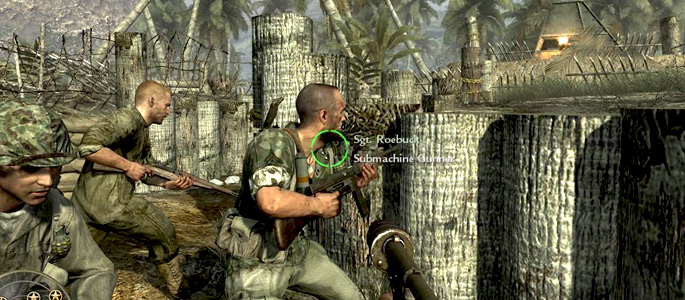
Thankfully, the missions really start to pick up after this lovely weapon is introduced, and the scope of the battlefield starts to expand. There’s a lot of intense firefights, and most of Miller’s campaign feels like an absolute mess. If you want to find out how insane a jungle-based battlefield is like, this is the place to learn. Oftentimes, I would end up aiming at friendlies who came out of nowhere, or even get spooked and stab a buddy (sorry bro) because there was too much debris or smoke onscreen. This is actually what the Pacific conflict was like, and I’m surprised Treyarch was bold enough to try it out.
Miller’s levels are good from a game play standpoint, but there really isn’t anything to latch onto in terms of narrative. Seriously, the only memorable character is your Sergeant, and that’s because he looks like Nathan Hale from Resistance: Fall of Man. Because it is a jungle setting, it almost feels like you’re fighting on one gigantic level. The ‘Blackcats’ air gunner mission mixes things up a bit, but has absolutely nothing to do with Miller since he’s on the mainland. Again, his missions are usually fun, but not always satisfying. The Pacific conflict is more about carnage and survival than compelling storytelling, but that’s where the Russian campaign comes in.
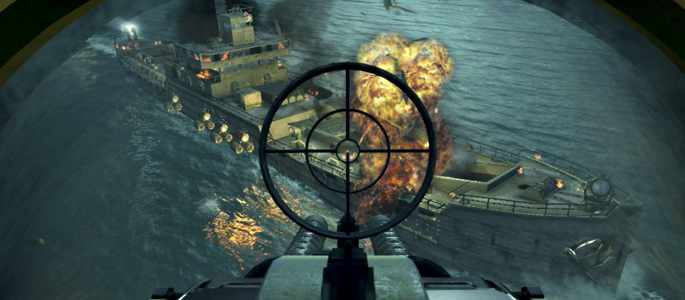
Private Petrenko’s missions are absolutely incredible, with cinematic set pieces that actually have a narrative behind them. Throughout his story, he’s accompanied by Sergeant Reznov, who acts more like an older brother than a commander. He’s constantly by Petrenko’s side, giving advice and reminiscing about old friends, lovers, and experiences in some of the war-torn buildings you travel through. It’s a very delicate touch with heavy undertones, and emphasizes how devastating WWII was on Russia. It also makes the later attacks in Germany that much more satisfying as you vicariously experience Petrenko’s revenge on the Nazis.
If you’ve ever played Modern Warfare, then World at War will feel instantly familiar. The control scheme is identical, the level progression is identical, and even the onscreen radar is right where you expect it to be. As soon as you turn on the game, the color and design of the menus are the same as Infinity Ward’s last installment. As such, the game immediately screams “Expansion Pack”, and in many ways it is. Like Modern Warfare, it follows two parallel storylines, and even Petrenko’s sniper assassination level brings to mind the sniper assassination level in Modern Warfare.
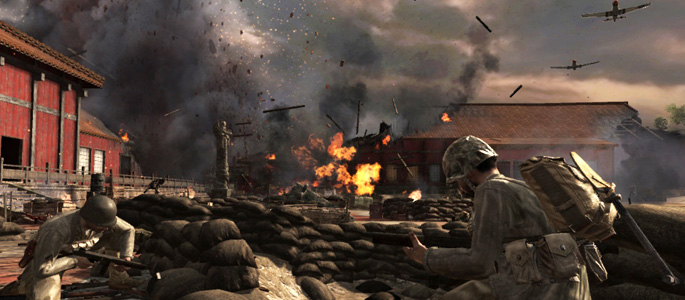
It’s due to all these similarities that I have to give Treyarch credit. The single player campaign for World at War truly stands on its own, and succeeds in making a name for itself in the series. They really took their time to build the campaign around the various weapons used in World War II, as well as to encourage constant experimentation. For example, I initially thought the Japanese bayonet was the most worthless weapon in existence due to the horrible aiming and reload mechanics. But then I started using it as a mid-range melee weapon, and instead used a secondary gun for all my headshot requirements. The flamethrower is also a great addition to the series, and is used in interesting situations.
Being able to rely on a stable engine prebuilt by Infinity Ward definitely helped them out a lot in terms of development time, but it also repeated some problems from the last game. The AI in this game is atrocious. I mean flat out horrible. Modern Warfare was able to hide this through constant scripting, but World at War has huge, open battlefields and jungle environments, and the fact that you can literally stand behind an enemy without them displacing or relocating appropriately is pretty sad. Some won’t even acknowledge your existence. I won quite a few battles by running into enemy lines and picking off enemies who didn’t notice the American/Russian standing right beside them. Makes the firefights a bit easier, but it still shouldn’t happen.
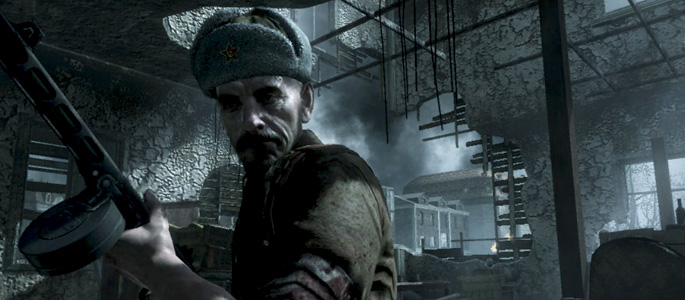
The graphics are also important to talk about. In still photos, the game looks great. In motion, it has not aged well. Characters have high quality normal mapping and various textures, but lack the animation needed to bring them to life (especially their faces). They feel more like dolls than human beings, especially with current titles pushing the boundaries of realistic human movement. The engine pushes more particle effects, but the polygon counts are still very low. Textures are detailed, but are low resolution and often lack any necessary shaders to make them pop. Hell, even the shadows are horribly aliased. This may have been acceptable when Modern Warfare came out, but not anymore, especially with Killzone 2 on shelves.
The saving grace of all these technical shortcomings is the impressive artistic direction taken with this title. The lighting style is spot on, and the environments, though lacking in detail at times, do accurately capture the atmosphere and horrors of war. The backgrounds are filled with billowing smoke and embers, and the action is constant. It’s also important to note that the framerate never stutters. Sound is also used effectively to certain degrees, but lacks physical accuracy. If a character is speaking you can hear them clearly, regardless if they’re 5 feet away or 100 feet away. This actually confused me a few times since I could hear someone giving a pretty significant monologue, but had no luck in finding them. This carries over to the weapon fire. Every gunshot and bullet impact sounds the same, regardless of the surface they hit and regardless of where they are relative to your position. The source material is good; it just lacks context and physicality.
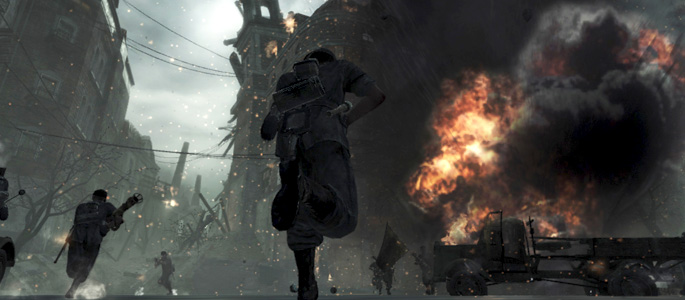
The campaign can be played through with 4-player co-op, and the missions actually becomes even more enjoyable since your teammates are typically smarter than the AI buddies. Sometimes. There’s only a few trophies awarded for going co-op, but everyone should definitely try it out. There’s also an awesome Nazi Zombie level that’s unlocked after beating the game, and players can play through any level they want in case there’s specific trophies they want in their collection. The online mode is decent, but nothing special. The level design is a mixed bag, and the german shepherds that you can unleash on your opponents are annoying. You usually can’t tell if you’re being attacked by one, and they constantly respawn. The inclusion of tanks was also a poor decision, as the team to first earn a tank typically wins the match. It’s fun at times, but nothing to brag about.
If you’re looking for a compelling online mode, you’re better off with COD4. But the campaign mode is pretty lengthy, and has some glorious set pieces. In fact, this is probably the first COD game that emphasizes campaign exploration over online mayhem, and there is a LOT to explore in this game. The death note collection cards are just one example, and because of this World at War has a lot of replay value. Yes, it often feels like a lengthy expansion pack, but it’s a great expansion pack, and is one of the best WWII games I’ve played thus far. It serves as an entertaining history lesson on aspects of WWII that are rarely touched upon, and keeps up a high-impact, frenetic pace all throughout. The final battles for each campaign are satisfyingly difficult, and Petrenko’s story is definitely worth experiencing. Despite some technical falters, it is a good game. And if you’re a fan of the series or just WWII games in general, I recommend giving World at War a shot.
PlayStation LifeStyle’s Final Score
Co-op is fun, but Multiplayer is bland. Campaign is action-packed, with a fairly compelling narrative. |
 |
